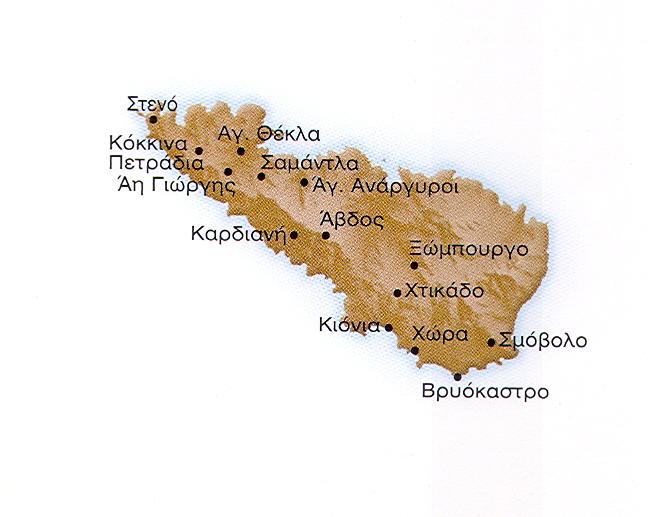TENOS
Tenos is a middle size island of the Cyclades. Its topography is dominated by the high of the mount Xomborgo who divides the island on two parts. On the North East the relief are abrupt, the landscape sometimes even look lunar. The South West part is softer; men can find shelters either on the land or in the sea in the coves. No surprise then to find the first settlement on the South West coast at Vryokastro. It was a typical site of the Early Bronze Age on a naturally fortified promontory 2km South of Chora. There the life continued until the Middle Bronze Age. From the Mycenaean times dates a tholos tomb at Agia Thekla attesting the presence in the 13rd century. However the settlement is still missing, it could be nearby the harbour of Panormos or inside the `cyclopean` walls at Xombourgo.
Some cemeteries are attested from Early Iron Age (eg Kardianni, Chtikado) but the main site developed just South of the Xombourgo peak reusing the partly preserved Mycenaean wall. There the recent excavation has uncovered a large cemetery that gradually became a worshiping place dedicated to the ancestors at the end of the Geometric and Archaic times. Not far away but extra muros was another vivid cult place from at least the archaic period and have been identified as a thesmophorion. The site of Xomborgo is occupied until the 4th century at least but the main urban centre of the classical times was under the present place of Chora. The asty was fortified in the 4th century at this time as a large aqueduc was built to bring water to the city. Within the walls traces can be found of some public buildings but the city plan is mostly unknown. Even the sanctuary of Dionysos mentioned by the sources remains missing.
The main sanctuary was outside the walls but still on the coast at modern Kiona. It was dedicated to the sea deities Poseidon and Amphitrite. A sacred way linked this sanctuary to city and with numerous tombs on the side. Tombs where are also to be found on the other roads leading to the remaining island and smaller settlements such as at Kokkina Petrradia and Ai Yorgis. Sanctuaries where also identified in the rural landscape, one dedicated to Gaia near Agia Thekla, and one of unknown deity just opposite to Andros.
Major advances for our knowledge of the earlier stages of formation of the Cycladic sanctuaries have occurred thanks to the excavations of the University of Athens directed by Nota Kourou at Xobourgo on Tenos, following the footsteps of Nikolaos Kontoleon. The past decade or so, an important cult place, allowing to observe the transition from an open air cult to a roofed temple has been revealed. The main element of the cult was the lighting of fire in pits in which offerings were thrown during a ritual. This open air cult was soon replaced by a probably roofed building (a “Sacred House”, as qualified by the excavator), decorated with the so far earliest known clay frieze with figured decoration.
BIBLIOGRAPHY
Artemis-Gyselen, L. 1977. Les monnaies archaïques de Ténos, RBelgNum 123 5-15.
Despinis, G. 1979. Ανασκαφή Τήνου, PAAH: 228-235.
Dorizas, G. I. 1970. To ιερόν τoυ Πoσειδώνoς και της Aμφιτρίτης στα Kιόνια της Tήνoυ, Athènes.
Etienne, R. 1984. Astu et polis à Ténos (Cyclades), Ktema 9: 205-211.
Etienne, R. & J.-P. Braun. 1986. Ténos I : le sanctuaire de Poséidon et d'Amphitrite, Athènes : Ecole française d'Athènes ; Paris : Diffusion de Boccard (Bibliothèque des Ecoles françaises d'Athènes et de Rome. 1ère série ; 263).
Étienne, R., N. Kourou & É. Simantoni-Bournia. 2013. Η αρχαία Τήνος, Athens.
Kourou, N. 2004. Η Τήνος κατά την Πρώιμη Εποχή του Σιδήρου. In Το Αιγαίο στην πρώϊμη εποχή του σιδήρου. Πρακτικά του Διεθνούς Συμποσίου, Ρόδος, 1-4 Νοεμβρίου 2002, edited by Σταμπολίδης, N. & A. Γιαννικουρή
Kourou, N. 2001. Tenos-Xobourgo: a New Defensive Site in the Cyclades, Karageorghis, V. & C. Morris (eds), Defensive Settlements of the Aegean and the Eastern Mediterranean after c. 1200 BC, Nicosie, 171-189.
Kourou, N. 2002. Tenos-Xobourgo: From a Refuge Place to an Extensive Fortified Settlement, Stamatopoulou, M. & M. Yeroulanou (eds), Excavating Classical Culture. Recent archaeological discoveries in Greece, Oxford, 255-268.
Kourou, N. 2007. Tenos. An Archaeological Forward, Moscati-Catelnuovo, L. (ed.) Tenos in epoca arcaica e classica, Macerata, 17-31.
Kourou N., Ten Years of Archaeological Research at Xobourgo (Island of Tenos in the Cyclades), Bulletin of the AAIA 3, 2005, 23-29.
Kourou N., The Dawn of Images and Cultural Identity: The Case of Tenos, in Alba della città, alba delle immagini ? Da una suggestione di Bruno d'Agostino, Tripodes 7, 2008, 63-90.
Kourou N., From the Dark Ages to the Rise of the Polis in the Cyclades: the Case of Tenos, in A. Mazarakis Ainian (ed.), The Dark Ages Revisited, Volos 2011, 399-414.
Leguilloux, M. 1999. Sacrifices et repas publiques dans le sanctuaire de Poséidon à Ténos : les analyses archéozoologiques, BCH 123-2: 423-455.
Reger, G. 1992. Athens and Tenos in the early hellenistic age, ClQ 42 365-383.
Zapheiropoulou, P. 1988. To Moυσείo της Tήνoυ, Athènes.


